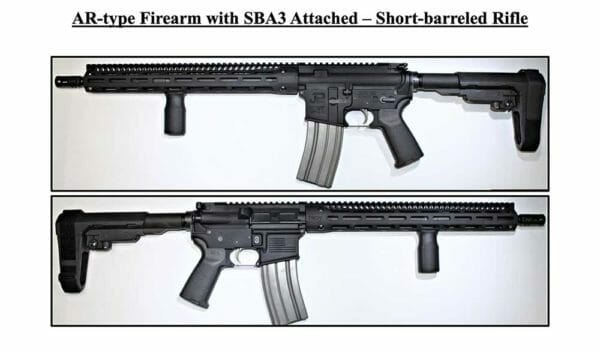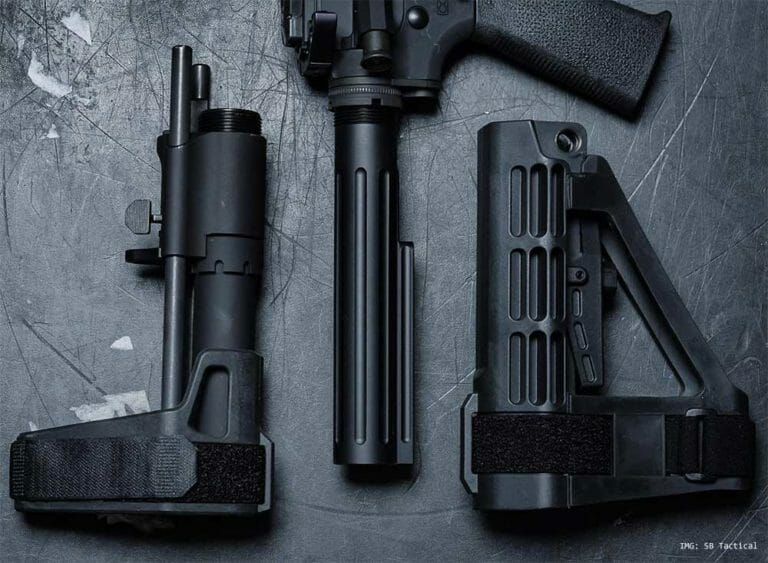WASHINGTON, D.C. -(Ammoland.com)- The Bureau of Alcohol, Tobacco, Firearms and Explosives (ATF) released its final rule surrounding pistol stabilizing devices killing off the market for the items unless court challenges prove successful.
The new rule (ATF final rule 2021R-08F) was published on the ATF’s website today and is set to be posted on the Federal Register on Monday, one day before the industry’s largest trade show, SHOT Show. The regulation will affect millions of Americans that currently own pistol stabilizing devices. What has been considered pistols for years will now be regarded as short barreled rifles (SBR) and be subjected to the National Firearms Act (NFA).
The proposed rule used a form known as “Worksheet 4999” to determine if a firearm equipped with a pistol brace would be considered an SBR by using a point system. The ATF ditched the form in favor of a widespread declaration that almost every pistol equipped with a brace of any kind would be considered an SBR.
“Worksheet 4999 was intended to ensure uniform consideration and application of the statutory definition of those terms. Based on the comments received, the Department agrees that the proposed Worksheet 4999 and point system did not achieve these intended purposes,” the Final Rule reads.
Under the new rule, any firearm that is “designed or redesigned made or remade and intended to be fired from the shoulder” will be considered an SBR.
This designation includes devices such as pistol stabilizing braces which the ATF assumes the shooter installed to be able to shoulder the gun. Also, if a firearm merely has the surface area that would allow it to be fired from the shoulder, the ATF might consider it an SBR if it has a weight or length consistent with a rifle.

Any pistol with a length of pull that is consistent with that of what would be found in a rifle would be considered an SBR. Any adjustable attachments, such as a multi-position buffer tube, would also automatically make the pistol an SBR. If the shooter places an optic on their firearm that requires an eye relief that is consistent with what’s used on a rifle, such as a scope, then that gun will also be considered a short barreled rifle. If a firearm has the surface area to be fired from the shoulder, such as a firearm equipped with a nonadjustable buffer tube, then that will be considered an SBR, basically making every AR-15 pistol and SBR.
“Whether the surface area that allows the weapon to be fired from the shoulder is created by a buffer tube, receiver extension, or any other accessory, component, or other rearward attachment that is necessary for the cycle of operations,” the document reads.
The ATF will also look at marketing material offered by the manufacturer to determine if installing that device on a firearm will convert it to an SBR. Several lawsuits involve companies suing over California’s law preventing the advertisement of firearms to people under the age of 18, including safety classes.
The ATF will also look at how the people in the firearms community use a gun to determine whether it is an SBR. You could use a device as intended by the manufacturer and still violate the rule if others use it in a way that is not consistent with how the manufacturer designed the device to be used.
There is a 120-day grace period to apply for a tax stamp for any device now considered an SBR that was previously considered a pistol.
Although the ATF states a 120-day grace period to register a pistol as an SBR, the ATF only promises not to enforce NFA rules on these devices for 60 days. The ATF will give a tax forbearance for the $200 tax stamp fee. A tax forbearance means that the ATF will not collect the $200 tax fee, although, by the law, you still owe the fee; it just will not be collected. The rule is set up the way it is because the ATF cannot waive a tax.
Gun owners must use e-Forms to file for the tax stamp. Only individuals would qualify for the tax stamp on devices with pistol stabilizing braces. If someone wanted to put the firearm into a trust, they must first register as an individual and then pay the $200 transfer fee to transfer it into a trust. Many people who own NFA items prefer having their firearms in a trust.
Some states do not allow for SBRs. Gun owners in those states do have options.
They could add a 16-inch or greater barrel, converting the firearm from a pistol into a rifle. In the past, the ATF has stated that a pistol could never be converted into a rifle, but the regulation seems to change this determination. The pistol stabilizing device could also be removed, and the gun owner can modify their firearms not to be able to accept a pistol brace. The gun owner also has the option of destroying the firearm. The final option would be turning the gun into the ATF for zero compensation.
The new regulation is expected to cost gun owners over $260 million. It is expected to cost the federal government over $3 million. In addition to the cost, it will put an increasing burden on the already overwhelmed NFA division of the ATF. the ATF claims that the average wait time will be 90 days, although Silencer Shop is showing a wait time of eight months for a tax stamp. Not only will it bog down the new tax stamp applications for SBRs, but it might drastically increase the wait time for other NFA items, such as sound suppressors.
There will be challenges to the new rule. The Second Amendment Foundation has an ongoing case in a federal District Court in North Dakota over the new regulation. Other legal challenges are expected shortly from other Second Amendment organizations.
Ammoland News reached out to SB tactical for a comment on the final rule but has not received one at the time of this writing.
About John Crump
John is a NRA instructor and a constitutional activist. John has written about firearms, interviewed people of all walks of life, and on the Constitution. John lives in Northern Virginia with his wife and sons and can be followed on Twitter at @crumpyss, or at www.crumpy.com.



So What Happens Now?
Under the new rule, you have a few options if your firearm falls into SBR territory.
Permanently remove and dispose of, or alter, the “stabilizing brace” such that it cannot be reattached
Remove the short barrel and install a barrel that is 16 inches or longer
Turn the firearm into the ATF; or
Register it with the ATF within 120 days of the rule being published and pay $200 for that tax stamp
Mountain State Sportsmen’s Association
The ATF uses “Chevron Deference” to unforce its “Rules” as de-Facto Law. The Supreme Court is taking up this issue this year on another Regulatory Agency ..”The National Marine Fisheries Service” who is doing the same S##$T as the ATF. If the ruling is favorable it should limit or erase the ATF’s rogue powers. GOA says this ………….
“The Constitution demands that ‘all legislative powers’ shall be vested in the Congress, not in rogue administrative agencies like the ATF,” “Americans have had enough of the Bureau’s unconstitutional gun bans, the most recent one affecting up to 40 million pistols; enough of the illegal gun running into Mexico via Fast & Furious; and enough of the maniacal Zero Tolerance Policy that has ended the livelihoods of honest gun dealers. GOA hopes the Supreme Court gives Chevron deference the death it deserves to better secure the rights of law-abiding gun owners.”